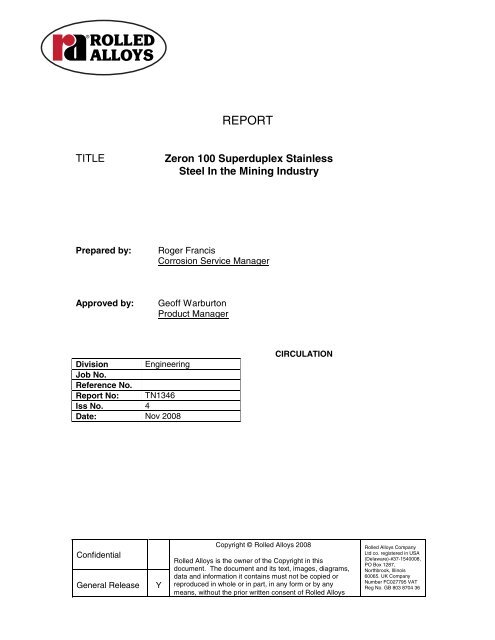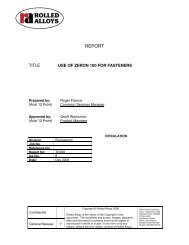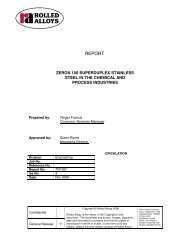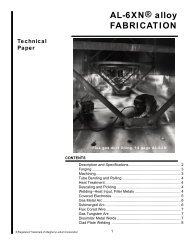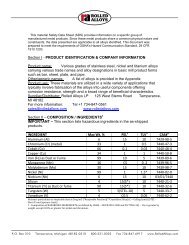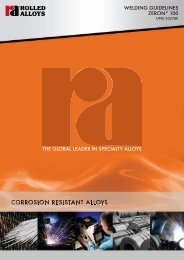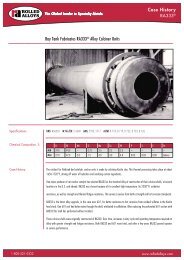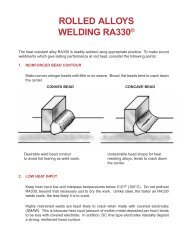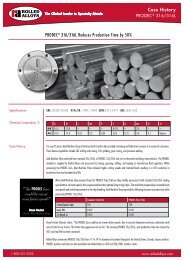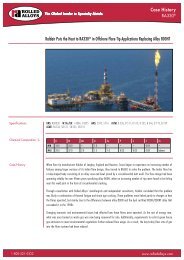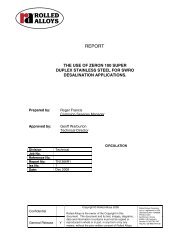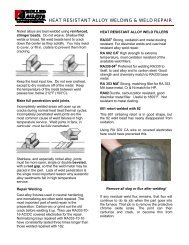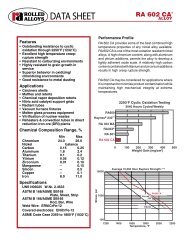ZERON 100 Mining Industry - Rolled Alloys
ZERON 100 Mining Industry - Rolled Alloys
ZERON 100 Mining Industry - Rolled Alloys
Create successful ePaper yourself
Turn your PDF publications into a flip-book with our unique Google optimized e-Paper software.
REPORTTITLEZeron <strong>100</strong> Superduplex StainlessSteel In the <strong>Mining</strong> <strong>Industry</strong>Prepared by:Roger FrancisCorrosion Service ManagerApproved by:Geoff WarburtonProduct ManagerDivision EngineeringJob No.Reference No.Report No: TN1346Iss No. 4Date: Nov 2008CIRCULATIONConfidentialGeneral ReleaseYCopyright © <strong>Rolled</strong> <strong>Alloys</strong> 2008<strong>Rolled</strong> <strong>Alloys</strong> is the owner of the Copyright in thisdocument. The document and its text, images, diagrams,data and information it contains must not be copied orreproduced in whole or in part, in any form or by anymeans, without the prior written consent of <strong>Rolled</strong> <strong>Alloys</strong><strong>Rolled</strong> <strong>Alloys</strong> CompanyLtd co. registered in USA(Delaware)-#37-1540008,PO Box 1287,Northbrook, Illinois60065. UK CompanyNumber FC027795 VATReg No. GB 803 8704 36
SUMMARYThis report describes the physical and mechanical properties of Zeron <strong>100</strong> along with itscorrosion resistance in a variety of acids and low pH, chloride solutions. The experiences withZeron <strong>100</strong> in the nickel laterite pressure acid leach process, as well as other applications in gold,copper and uranium mining are described.Copyright © <strong>Rolled</strong> <strong>Alloys</strong> 2008Report No. TN1346Issue No. 4Page 4 of 22
PD5500 in Zeron <strong>100</strong> is 3.5m diameter, 4.5m tall and 20mm thick and it has been inservice with a UK pigments manufacturer since 1996 with no problems. Larger vesselshave been manufactured to ASME VIII division I, such as a mixed sulphides vessel at anickel laterite mine, mine that was ~ 3m diameter and 20m long.Zeron <strong>100</strong> is readily welded by all the commonly used arc welding processes. It isusually welded with Zeron <strong>100</strong>X consumables, which contain extra nickel to ensure thecorrect phase balance of the weld metal in the as- welded condition. Like all high alloystainless steels, Zeron <strong>100</strong> requires welders experienced in stainless steel fabricationworking to approved and qualified procedures.Supply is not a problem because Zeron <strong>100</strong> is readily available in all the common productforms, including castings, pipes, fittings, flanges, plates, bar, billet, fasteners etc. A largestock is currently held in all these product forms in RA Materials, Manchester warehouse.3. CORROSION3.1 Acid LeachDuring many mining operations leaching is often carried out with sulphuric acid. Zeron<strong>100</strong> has excellent resistance to sulphuric acid, better than many of the alloys in Table 1,including other superduplex stainless steels such as UNS S32750, as shown by the isocorrosioncurves (0.1mm/y) in Figure 1. This is because the latter alloy does not containany copper or tungsten.Sulphuric acid used in extraction processes often contains impurities and a common oneis the chloride ion. Figure 2 shows the iso-corrosion curves (0.1mm/y) for Zeron <strong>100</strong> andsome other common stainless steels in sulphuric acid containing 2,000 mg/l chlorides. Itcan be seen that Zeron <strong>100</strong> has superior corrosion resistance not only to the commonstainless steels, but also compared with other high alloy stainless steels such as S31254(a 6% Mo super austenitic) and S32750 (a 25% Cr superduplex).There are other ions which could be present and which can influence corrosionresistance. Other halides, such as fluorides and bromides, will decrease corrosionresistance in a similar manner to chlorides. Oxidising species, such as ferric and cupricions, have a beneficial effect and increase corrosion resistance. Figure 3 shows theeffect of 50 mg/l ferric ions and <strong>100</strong> mg/l cupric ions on the iso-corrosion curve of Zeron<strong>100</strong> in sulphuric acid. However, halide ions are often also present with these oxidisersand so the exact concentration of each will determine the corrosion resistance. However,Zeron <strong>100</strong> consistently performs well in such solutions.In some extraction processes hydrochloric acid is preferred and Zeron <strong>100</strong> has goodresistance to dilute acid at high temperature as shown in Figure 4, especially whencompared with other grades of stainless steel.Many processes involving sulphide ores utilise oxygen sparging at elevated temperaturesin acid environments. An autoclave test was carried out under the following conditions tosimulate a typical environment:NaClMgSO 4NiSO 414 g/l15 g/l52 g/lCopyright © <strong>Rolled</strong> <strong>Alloys</strong> 2008Report No. TN1346Issue No. 4Page 6 of 22
pH 2Temperature <strong>100</strong> o CPressure 10 bar (O 2 )Samples of Zeron <strong>100</strong> were tested to assess resistance to general corrosion, crevicecorrosion and stress corrosion cracking, with exposure for 3 weeks. The corrosion ratewas ~ 0.03 mm/y and there were no signs of crevice corrosion or stress corrosioncracking.Note that in oxidisation pressure leach applications, the conditions become moreaggressive as the chloride and oxidiser (such as ferric and cupric ions) concentrationsincrease. When both oxidisers and chlorides are at high concentrations, it is possible toget localised pitting, particularly in shielded areas. It is important to consider each projectindividually under its own specific conditions.3.2 High Pressure Acid LeachingHigh pressure acid leaching of metals from ores has been used in a number of locationsaround the world and it is being used for extracting nickel from the laterite ores inWestern Australia. Plants in other parts of the world are currently under construction. Inthis method crushed ore is heated to temperatures of about 250 o C and the nickel isextracted with sulphuric acid at about 50 bar pressure.In Western Australia there is a shortage of fresh surface water in sufficient quantities forthis process, although there are numerous boreholes producing high chloride brines (15to 150 g/l chloride). To use conventional plant materials it would be necessary to reducethe salinity of the water substantially by desalination. This would be extremely expensive,both in terms of the cost of the plant and its operating costs. The alternative is to use theborehole water as it is and build the plant of suitable corrosion resistant materials.Figure 5 shows a simplified schematic diagram of the ore processing chain. Two heatingand cooling stages are shown, but in practice there could be four or more stages prior toand after the main autoclave. During heating, a mixture of crushed ore and water issteam heated in stages until it is injected into the main autoclave. Sulphuric acid is addedeither to the autoclave or immediately prior to it. After reaction in the autoclave theresidual slurry is progressively cooled through a series of flash tanks. Steam extractedfrom each tank is used to provide heat during the heating stages (Figure 5). Followingthis the slurry is at about <strong>100</strong> o C and it must be further cooled, separated and neutralisedprior to extraction of the nickel.3.2.1 Heater FluidsIn the directly heated vessels, as shown in Figure 5, the steam from the flash tank stripsmost of the oxygen from the incoming slurry, but the carry over of acid can mean that thepH could drop to 3. Under severe upset conditions even lower pH’s have beenpostulated. A series of autoclave tests was conducted in a simulated laterite slurry of thefollowing composition at different pH’s at 200 o C, a typical autoclave injectiontemperature:-Copyright © <strong>Rolled</strong> <strong>Alloys</strong> 2008Report No. TN1346Issue No. 4Page 7 of 22
MgSO 4 - 15g/lFe 2 (SO 4 ) 3 - 150 mg/lNaCl - 150, 17 or 1.7 g/lpH - 1,2 or 3The results in Table 4 show that at normal pH (3) the corrosion rate was low and even atpH2 the corrosion rate was still acceptable. However, at pH1 the corrosion rate was veryhigh and caustic injection or something similar would be required to prevent excessiveattack if this occurred in service. Samples were also included to test for crevice corrosionand stress corrosion cracking (SCC). Neither was observed. The direct injection ofsteam into the heater vessels increases the slurry volume by up to 10% and it has beenproposed that indirect heating of the slurry, in a series of heat exchangers, would bemore economical. This will depend on the price of steam for the particular project. Withindirect heating the slurry inside the tubes is no longer deaerated, and the risk ofcorrosion is greater.Independent laboratory tests to simulate the indirect heater environment (hightemperature, aerated slurry) showed that all stainless steels cracked at 200 o C. Only Ti-Ni(grade 12) and Ti-Pd (grade 16) resisted attack. Heating the slurry from ambient to200 o C requires a large number of heat exchangers in series and superduplex stainlesssteel is suitable for the first few stages where the temperatures are lower.3.2.2 Flash Tank FluidsThis environment, which is the spent liquor from the autoclave, is progressively cooledfrom 250 o C to ~ <strong>100</strong> o C. Acid concentrations are about 40 g/l with chlorides plussulphates of nickel and cobalt. Autoclave tests at 177 o C showed excessive corrosion ofalloy 20, 6% Mo austenitic and Zeron <strong>100</strong>. In addition the alloy 20 and 6% Mo austeniticwere pitting, and the C-rings showed severe cracking. Tests at different chloride levelsgave similar results and the corrosion seems to be controlled more by the acid content.These stainless steels are clearly unsuited for this environment.The exception to this was at <strong>100</strong>°C with 40 g/l acid . Zeron <strong>100</strong> corroded at a low rate(0.015mm/y max) with no localised corrosion or SCC with up to 5g/l chloride. With 20g/lchloride the corrosion rate increased (0.265mm/y) and pitting occurred.3.2.3 ThickenersAfter leaving the final flash tank at about <strong>100</strong> o C the slurry may be passed through a heatexchanger prior to separation of the solids and liquids in a series of thickeners. Thesehave long arms with rakes which are normally made of coated carbon steel. Bare metalis used for components such as hangers and pivots, which must be made of corrosionresistant alloys. Alloy 904L is sometimes used but in more aggressive environments thegreater corrosion resistance of Zeron <strong>100</strong> is required.The first thickener contains the most corrosive environment and tests were carried outunder the following conditions:CoSO 4 - 1.0 g/lFeCl 3 - 1.5 g/lNiSO 4 - 9.2 g/lCopyright © <strong>Rolled</strong> <strong>Alloys</strong> 2008Report No. TN1346Issue No. 4Page 8 of 22
MnCl 2 - 2.3 g/lMgSO 4 - 75 g/lNaCl - 150 g/lH 2 SO 4 - 15.5 g/lTemperature - 60 o CSamples of Zeron <strong>100</strong> were tested for general corrosion, crevice corrosion, pitting orstress corrosion cracking, in a 30 day exposure. The weight loss showed a corrosion rate
In the copper mining industry the extraction of the copper is often by sulphuric acid andelectroplating. Zeron <strong>100</strong> has been used for pumps handling the spent acid, which isoxidising because of the presence of Cu 2+ ions, it may contain chlorides and it is typicallyat about 60 o C. The spent acid can also be abrasive because of the presence of residualsolids. Zeron <strong>100</strong> gives excellent performance at 60 o C up to ~ 35 wt% acid. Figure 7shows a Zeron <strong>100</strong> pump in a copper mine in the USA.4.2 Copper ExtractionBecause of its excellent resistance to hot sulphuric acid, particularly in the presence ofchlorides and copper, Zeron <strong>100</strong> has found applications in copper extraction plants. TheEscondida mine in Chile has used NPS 48 and NPS 20 Zeron <strong>100</strong> piping to handle spentacid liquors. These pipes replaced rubber lined carbon steel, where the rubber detachedfrom the steel after only a short time in service. Zeron <strong>100</strong> has been used by the sameproject for seawater lift pumps, taking seawater up to the mine site because of theshortage of fresh water.The Spence project in Chile uses a bio-leach reactor to extract copper from the ore.Sulphur oxidising bacteria produce sulphuric acid as a by-product, dissolving copper fromthe ore. Zeron <strong>100</strong> has been used for the pipes carrying the dissolved copper, which alsoincludes spent sulphuric acid and chlorides.When copper is plated from solution, it is usual to use 316L stainless steel starter plates.These have polished faces so that the copper can be easily separated from the stainlesssteel at intervals. When the acid solution contains high levels of chlorides, the 316L canpit and these pits act as keys preventing the copper from detaching easily. With its highresistance to chlorides in acid solutions Zeron <strong>100</strong> is a candidate to replace 316L forstarter plates. The Cyprus Bagdad Copper Company has used Zeron <strong>100</strong> starter platesat its plants in Arizona, USA and at El Abra in Chile.4.3 Nickel Laterite OresZeron <strong>100</strong> has been extensively used in the laterite ore processes in Australia,particularly on the Murrin Murrin Project and to a lesser extent in the Bulong Nickel andCawse projects, Table 6 shows some of these applications, as well as those from someother mining projects.RA Materials have supplied pipes, fittings and flanges to project suppliers for a variety ofareas within the laterite mining projects. In addition Zeron <strong>100</strong> has been supplied to themanufacturers of original engineered equipment such as agitators and mixers.The positive displacement slurry pumps are very large, as shown in Figure 8, and use amixture of cast and wrought Zeron <strong>100</strong> for the wetted parts. They operate at ~ 180°C atpH values down to ~3. The process vessels in the Murrin Murrin project are very largeand Figure 9 shows the mixed sulphides vessel. During start up and shut down of reoxidationvessels the conditions can go strongly reducing and the greater acid resistanceof Zeron <strong>100</strong> can be an advantage over 22%Cr duplex, which has experienced severecorrosion under these conditions on some projects.In the steam return lines from the flash tanks to the heater vessels the acid carry-over isestimated to be 1-3 g/l. Depending on the chloride concentration in the slurry, this couldbe a mixture of sulphuric and hydrochloric acids (high chloride) or mostly sulphuric acidCopyright © <strong>Rolled</strong> <strong>Alloys</strong> 2008Report No. TN1346Issue No. 4Page 10 of 22
(low chlorides). Superduplex stainless steel has been used for the steam return lines insome laterite ore projects. On the Murrin Murrin project they were replaced by titaniumdue to excessive slurry carry-over from the flash tanks. With improved flash tank design,acid slurry carry-over should not occur and Zeron <strong>100</strong> should work well.Laboratory corrosion tests have shown that the corrosion rate of Zeron <strong>100</strong> is low(
TABLE 1 The composition of some stainless steelscommonly used in acid leach mining.ALLOYNOMINAL COMPOSITION (wt%)Fe Cr Ni Mo N Cu WPREN<strong>ZERON</strong> <strong>100</strong> (Wrought)<strong>ZERON</strong> <strong>100</strong> (Cast)316L22% Cr DuplexAlloy 20904L6% Mo Aust.bal 25 7 3.5 0.25 0.7 0.7bal 25 8 3.5 0.25 0.7 0.7bal 17 10 2 - - -bal 22 5 3 0.16 - -bal 20 35 2.5 - 3.5 -bal 20 25 4.5 - 1.5 -bal 20 18 6 0.2 0.7 -> 40> 402434283543bal = balancePREN = %Cr + 3.3 x %Mo + 16 x %NTABLE 2 Minimum mechanical properties of some stainlesssteels commonly used in acid leach mining.ALLOY0.2% PROOF UTS ELONG nSTRESS (MPa) (MPa) (%) HARDNESS*(HRC)<strong>ZERON</strong> <strong>100</strong> (Wrought)5507502528<strong>ZERON</strong> <strong>100</strong> (Cast)4507002524316L170485402222% Cr Duplex4506502528Alloy 202405503022904L22049035226% Mo Aust.3006503522* - maximumCopyright © <strong>Rolled</strong> <strong>Alloys</strong> 2008Report No. TN1346Issue No. 4Page 12 of 22
TABLE 3Design stresses for some common stainless steelsat room temperature.ALLOYDESIGN STRESS (MPa)PD 5500(Vessels)ASME VIII Div. 1(Vessels)ASME B31.3(Pipes)<strong>ZERON</strong> <strong>100</strong> (Wrought)319214250316L15011511522Cr Duplex289177207Alloy 20NL1581616Mo Aust.NL185207NL – not listedCopyright © <strong>Rolled</strong> <strong>Alloys</strong> 2008Report No. TN1346Issue No. 4Page 13 of 22
TABLE 4The corrosion of Zeron <strong>100</strong> in a simulated lateriteheater fluid versus chloride and pH at 200 o CSAMPLE pH CHLORIDE(mg/l)CORR n RATE(mm/y)AB3390,00090,000
TABLE 6Some experiences with Zeron <strong>100</strong> pumps in theNorth American mining industry.MINERAL PROJECT NO. OF PUMPSPotashPotash Corporation(Canada)SaskatchewanIMC (Canada)Kalium (Canada + USA)Cominco-Agrium (Canada)4761GoldBousquet (Canada)[mine water]1NickelINCO, SudburyFroude mine [drainagewater]12CopperArizona, USA[sulphuric acid + solids]4 + 1Copyright © <strong>Rolled</strong> <strong>Alloys</strong> 2008Report No. TN1346Issue No. 4Page 15 of 22
TABLE 7Some applications of Zeron <strong>100</strong> in mining andmineral extraction.ITEM PROJECT APPLICATIONSlurry PumpsSlurry PumpsThickenersThickenersThickenersMixersMixersVessel (Mixed Sulphide)Pipes/Fittings/FlangesSparge PipesPipingPipingPipingCentrifugesBulong NickelMurrin MurrinOlympic DamBulong NickelMurrin MurrinOlympic DamMurrin MurrinMurrin MurrinMurrin MurrinLihir-EscondidaSpenceTioxideNickel (laterite)Nickel (laterite)UraniumNickel (laterite)Nickel (laterite)UraniumNickel (laterite)Nickel (laterite)Nickel (laterite)GoldRutileCopperCopperRutileCopyright © <strong>Rolled</strong> <strong>Alloys</strong> 2008Report No. TN1346Issue No. 4Page 16 of 22
FIGURE 1 Iso-corrosion curves (0.1mm/y) forsome stainless steels in sulphuric acid130120110Boiling Point Curve<strong>100</strong>Temperature (° C)908070<strong>ZERON</strong> <strong>100</strong>605040316LS32750904LAlloy 206%Mo Aust.300 10 20 30 40 50 60 70 80 90 <strong>100</strong>Acid Concentration (wt.%)FIGURE 2 Iso-corrosion curves (0.1mm/y) forsome stainless steels in sulphuric acid plus2,000mg/l chlorideCopyright © <strong>Rolled</strong> <strong>Alloys</strong> 2008Report No. TN1346Issue No. 4Page 17 of 22
FIGURE 3 Iso-corrosion curves (0.1mm/y) forZeron <strong>100</strong> in sulphuric acid with oxidizers130120110Boiling Point Curve+ 50ppmFerric ionsTemperature (° C)<strong>100</strong>908070<strong>ZERON</strong> <strong>100</strong>+ <strong>100</strong>ppmCupric ions605040300 10 20 30 40 50 60 70 80Acid Concentration (wt.%)FIGURE 4 Iso-corrosion curves (0.1mm/y) forsome stainless steels in hydrochloric acid120110<strong>100</strong>Boiling Point Curve90Temperature (° C)807060S32750<strong>ZERON</strong> <strong>100</strong>50316L406%Mo Aust.300 1 2 3 4 5 6 7 8Acid Concentration (wt.%)Copyright © <strong>Rolled</strong> <strong>Alloys</strong> 2008Report No. TN1346Issue No. 4Page 18 of 22
FIGURE 5 Schematic diagram of the high pressure acid leachsection of a nickel laterite plant.Copyright © <strong>Rolled</strong> <strong>Alloys</strong> 2008Report No. TN1346Issue No. 4Page 19 of 22
FIGURE 6 Erosion of several alloys in a sandladen brine at 55° C2019Sand = 640mg/lVelocity = 40m/spH = 3.5Chloride = 25g/lTemperature = 55°C1817Weight Loss (mg)16151413121110316L 22%Cr Duplex Alloy 825 Z<strong>100</strong>AlloyCopyright © <strong>Rolled</strong> <strong>Alloys</strong> 2008Report No. TN1346Issue No. 4Page 20 of 22
Figure 7 A Zeron <strong>100</strong> pump in a copper mine in the USAFigure 8 Geho positive displacement pumps in Zeron <strong>100</strong> for anickel laterite mining project in AustraliaCopyright © <strong>Rolled</strong> <strong>Alloys</strong> 2008Report No. TN1346Issue No. 4Page 21 of 22
Figure 9 Mixed sulphides vessel for a nickel laterite mining projectFIGURE 10 Oxygen sparge pipes for main autoclave at Lihir gold mine, PNGCopyright © <strong>Rolled</strong> <strong>Alloys</strong> 2008Report No. TN1346Issue No. 4Page 22 of 22


